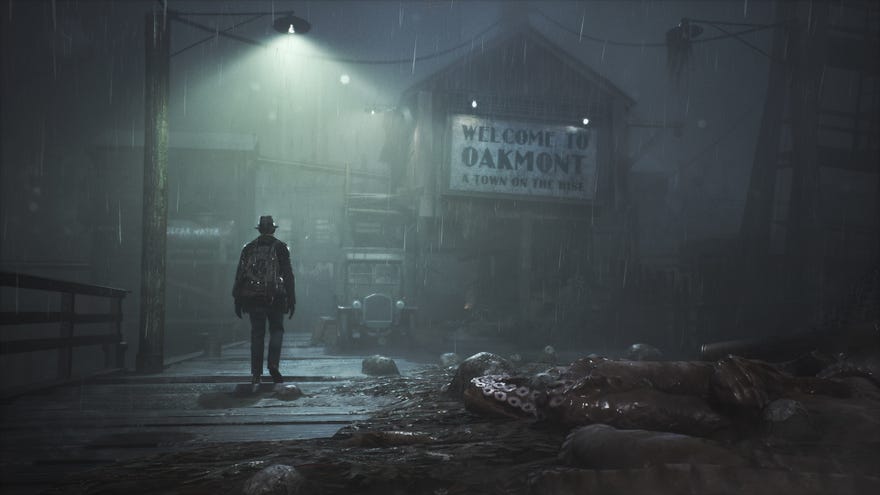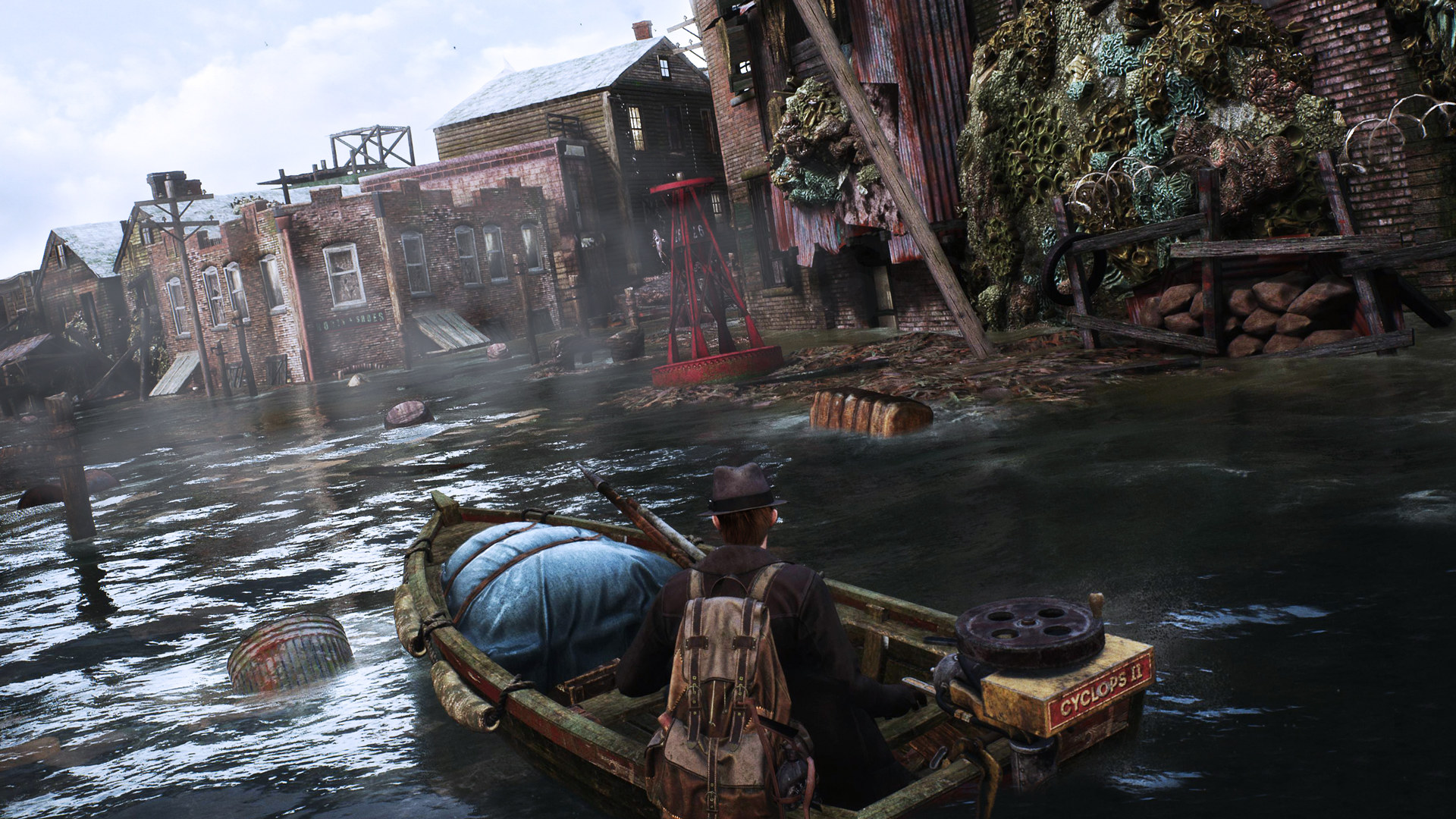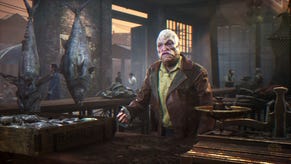How The Sinking City is built to make you notice your journey
Oakmont, so good they named it once
I sometimes announce, to rooms at large, that I wished Assassin’s Creed Odyssey wouldn’t tell me what to do as much, and let me just explore. Imagine my shock, therefore, at the reveal of The Sinking City, a Lovecraftian detective game releasing just the other side of E3, promising “zero hand holding”. No objective markers on the map, and no trails on the street to follow - just your own wits.
“In The Sinking City we have a map, and every street has a name,” said Waël Amr, the CEO of developers Frogwares. “The evidences tell you that the cross road on this street and this street -- you have to physically go there, and you have to find the house, the place, the person that you're looking for there.”
As detective Charles W. Reed, you’re supposed to be able to take your time and look at the fictional city of Oakmont, Massachusetts, at your leisure. And with place names rather than quest markers to work with, yo'll have to really get to know the place. Amr mentions the idea of “dwelling” in the city, having emotions attached to it. He asks me where I live in real life, and if I have favourite places there. Places that, when I walk through them and see them, recall feelings. “This is not something which is proposed today in most games,” he said. “Zelda does that. Zelda gives you the feeling of the place, of the genius loci.”
A genius loci was the protecting spirit of a place in Ancient Rome. Today it means something similar, although the word “spirit” is less literal. It’s the unique atmosphere of a place: its layers of history, its locality, its usage, and its people. Amr used the term, as well as others from architecture and urbanism, a lot, and referred to The Legend Of Zelda: Breath Of The Wild a couple of times.
“When I made the first presentation of The Sinking City back in 2016, all the people that sell games and don't play them told me ‘It's impossible’,” he said. But then a year later, Breath Of The Wild came out, giving everyone an open world but without dozens of markers to aim for. “After that we didn't have to convince people that free investigation is something that is actually doable.”
Frogwares is the studio behind the Sherlock Holmes games, the most recent of which was Sherlock Holmes: The Devil’s Daughter. I liked it because (a) I like detectives (b) its particular incarnation of Watson looked like the hot, probably bisexual barista who flirts with you in your local artisanal coffee shop and (c) it didn’t always tell you what the answers were. Your options weren’t clearly delineated between correct things to do and bad, wrong things to do. “After this, we said 'Okay, but what is the part of detective work that we couldn't explore in the linear adventure?' - and it's the way that you have to actively think where you have to go,” Amr explained.
In The Sinking City you, the player, have to decide what to do next, every time. To achieve that, Frogwares had to change “everything” at the studio. In the end they spent two years developing tools, and only a year on principal production of the game. “I'm very happy with the result,” Amr said, adding that they didn’t crunch, or work evenings or weekends. “The team grew, it's a better atmosphere, a better culture, a better understanding.”
Frogwares also worked with architects, and Amr himself studied architecture for several months in order to be able to implement it properly. His team did studies on coastal cities and port organisation, on how cities in the US developed from the 17th century onwards, and on how main streets, side streets and arterial roads all connect. And although Oakmont is placed in Massachusetts, it looks more like a medieval European city -- it’s closest model in the States is Boston, which has a city centre that’s a bit more wiggly and strange than the usual grid system. Amr got very animated when describing said system.
Its nature, he said, comes from a combination of things: the introduction of railroads allowing people to travel to new cities easily, mass immigration due to events like the famine in Ireland, and sudden baby booms. All these things contributed to the need for new districts to be built -- and quickly -- rather than growing up slowly over time. In this period of accelerated growth, land was given out on a lottery system, in easy square parcels.
“It's very boring to move yourself!" argued Amr of cities with grid layouts. "'It's two blocks further', [you say to yourself], and you end up not taking care of the journey. You're not interested in the journey, you're interested only in the destination.” In a European city, by contrast, Amr said directions were more a case of “go straight on here, then take the second right, and you’ll come to a big red building…” and so on.
Americans, he said, have a tendency to shift their destination-focused mentality into the games they make, while Europeans -- by and large -- "will be more interested in the journey, because in any city you have a flavour.” Consequently Oakmont, which to my eyes looks like London does on a wet, Wednesday afternoon when I’m in a bad mood, only has one grid-based area on its map.
Again and again, Amr went back not to architecture, but to feelings. To the emotions associated with a place being more important than the final destination, and to the importance of the journey itself [maybe the real horror was the friends we made along the way? - Ed]. He said that because games today can provoke a wider and deeper range of emotions than ever before, players are naturally demanding it from them. “What I know is that our work is based on emotion,” he said. “Today even in the way that we produce games, we are interested more in the emotional intelligence of people doing them.”
Amr thinks Frogwares' gambit has worked, noting that after about 10 hours, players start knowing streets and places in Oakmont by their names, as intended. But he also acknowledges the potentially difficult contradiction at The Sinking City’s heart: it is a game with a story - which means it’s in some way linear - but it removes the hand-holding we expect from a linear experience. Reconciling that conflict is a tough one, and as a player I worry it risks leaving people feeling too adrift, finding things too hard. I myself have a habit of being paralysed by choice, but I still love the idea of an opportunity to actually reason things out for myself.
“I’d really had enough of this tendency of the industry to say games are for children," concludes Amr, rejecting the idea of an "infantilisation" of the target audience in order to be sure of engaging them. He believes this mindset comes from “people that don’t even play games”, and compares it to a person who’s never played golf becoming a golf coach on the basis that golf is "just a stick and a ball."
“It's a very deep medium, an interesting and deep medium, and it's obviously not treated as such, even by the investors that are looking at it.” Amr said that larger studios are now looking at what Frogwares are doing, and asking themselves why they can’t do it too. “The answer is that there is a kind of self-censorship, about not going too far. I think it’s a complete mistake.”
All this would, of course, double handily as an inbuilt excuse should the game underperform. If people don’t like The Sinking City, it could be argued it’s because they don’t get it, or because the industry isn’t ready, and so on and so forth. And while Amr is confident that people will like it, I get the sense he’ll be more frustrated than a developer usually is if they don’t. “I will try to demonstrate that what I do is a rightful course. I might be completely wrong as well,” he said. But he was laughing quite happily when he said it.











